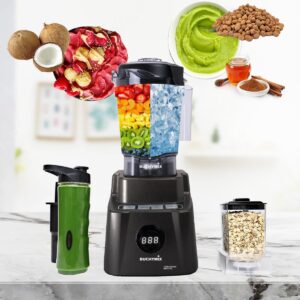

When it comes to kitchen appliances, food processors and blenders are two must-have items that make cooking and food preparation easier. Although they may initially appear to be similar, they have unique features and serve varied functions to accommodate a range of culinary chores. We’ll go over the top ten distinctions between food processors and blenders in this blog post so you can learn about their distinct features and choose the one that works best for you.
1. Purpose and Functionality
Food Processors:
Purpose: Food processors are designed to streamline various food preparation tasks, offering efficiency and versatility in the kitchen.
Functionality: Food processors excel at tasks such as chopping, slicing, dicing, grating, and mixing ingredients. They are particularly useful for preparing ingredients for recipes that require uniform cuts or blending multiple ingredients together. Additionally, food processors can handle heavier tasks such as kneading dough and making nut butter, offering a wide range of culinary possibilities.
Blenders:
Purpose: Blenders are primarily utilized for creating smooth textures by blending ingredients together, making them essential for preparing a variety of beverages, soups, sauces, and purees.
Functionality: Blenders excel at mixing liquids and soft ingredients to create smooth and homogeneous textures. They are particularly effective for blending fruits, vegetables, ice, and liquids to make smoothies, shakes, soups, sauces, and purees. Blenders offer convenience and speed in achieving desired textures, making them indispensable appliances for many kitchen tasks.
2. Blade Design
One of the noticeable differences between food processors and blenders is their blade design. Food processors typically come with multiple interchangeable blades suited for different tasks, such as a chopping blade, slicing disc, shredding disc, and dough blade. These blades are designed to handle solid and semi-solid ingredients with varying textures.
In contrast, blenders have a single set of sharp blades attached to the bottom of the blending jar. These blades are specifically designed for blending liquids and soft ingredients, creating smooth and homogeneous mixtures.
3. Texture and Consistency
Food processors and blenders produce different finished products in terms of texture and consistency. Depending on the blade used, food processors are excellent for producing coarse or fine textures. For instance, a food processor can be used to achieve finely minced vegetables or chunky sauce.
Conversely, blenders are excellent at producing creamy, smooth textures. Smoothies, smooth soups, and rich sauces are all made possible by them because they thoroughly combine all ingredients into a uniform creation.
4. Liquid Capacity
Generally speaking, blenders hold more liquid than food processors do. Because of this, blenders are perfect for making big quantities of sauces, soups, and drinks. Although they can contain liquids, food processors work best when processing smaller amounts of materials at once.
5. Blender’s Speed and Power
Because of their strong motors, which can quickly break ice, grind fruits and vegetables, and produce smooth mixes, blenders are renowned for their high-speed blending capabilities. Food processors feature strong motors as well, but they run at slower rates and are primarily used for operations like precise chopping, slicing, and mixing.
6. Versatility
Food processors are very adaptable kitchen tools that can be used for a variety of jobs, such as slicing vegetables, kneading bread, shredding cheese, and processing nuts. Their adaptability is increased by the changing blades and attachments, which let you easily complete a variety of recipes.
Although they are mainly used for blending liquids and soft substances, blenders can also be used for other purposes, such as smashing ice, pureeing fruits, and, with the appropriate attachments, grinding some dry components.
7. Size and Footprint
When it comes to size and footprint, blenders are often smaller than food processors and require less counter space. Because of this, blenders are a popular option for people who want to save room in their kitchen or have smaller spaces.
Food processors are typically bulkier and require more storage space because of their larger capacity and flexible functions. Nonetheless, a few modern food processors have elegant designs and offer little storage spaces for their attachments.
8. Control Options
Blenders often have a few speed settings, a pulse function, and not much control over the machine. Blenders are simple to use because of this, especially for jobs that call for constant mixing.
More control choices, such as pulse functions, variable speed settings, and dedicated modes for chopping, pureeing, and kneading, are frequently included with food processors. This degree of control makes it possible to process materials precisely to achieve the right consistency and texture.
9. Cleaning and Maintenance
Both food processors and blenders are relatively easy to clean, with most parts being dishwasher safe. However, food processors may require more attention when cleaning due to their multiple blades, discs, and attachments.
Blenders, with their single-blade design, are usually quicker to clean and maintain. Simply rinsing the blending jar with soap and water or running a cleaning cycle with water and detergent can suffice for most cleaning needs.
10. Cost
The cost of food processors and blenders can vary depending on the brand, model, features, and functionality. Generally, blenders tend to be more affordable than food processors, especially basic models designed for simple blending tasks.
However, high-end blenders with advanced features such as variable speed controls, preset programs, and powerful motors can be quite expensive and comparable in price to mid-range food processors that offer a wide range of functions and attachments.
In brief, although food processors and blenders have many features in common, they are two different kitchen machines with special uses. Depending on your culinary preferences, recipes, and available kitchen space, knowing the distinctions between a food processor and a blender will help you make an informed choice.
To improve your cooking experience and broaden your recipe repertoire, food processors and blenders can be useful additions to your kitchen equipment, regardless of your priorities. These include texture control, convenience of use, adaptability, and capacity for liquid mixing.

